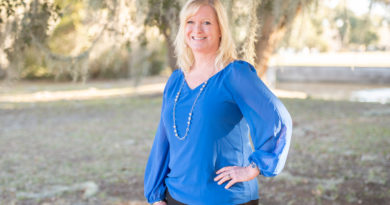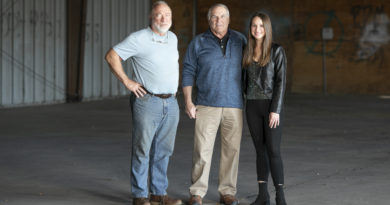By the sea, by the sea, by the Beautiful Sea
Story by MARY ELLEN THOMPSON
Photography by PAUL NURNBERG
Dick Geier, President of Friends of Hunting Island State Park, is a man with a vision and a take no prisoners attitude; if there is a job to be done, he will get it done. Like past presidents before him, and the 800 families that comprise the Friends of Hunting Island, he is working tirelessly not only to save Hunting Island from being reclaimed by the sea, but also to make sure it is maintained and preserved for future generations.
Developed as a State Park in 1935, Hunting Island is a treasure in the South Carolina State Park system, and a gem in the treasure chest of Beaufort County. Of the 47 state parks in South Carolina, Hunting Island is the single most popular of them all with more than a million visitors a year. Hunting Island State Park faces a myriad of issues, both as a barrier island, and a park in a system that doesn’t have funding to preserve it. That’s where the Friends of Hunting Island step in.
Dick Geier explains, “The Parks, Recreation and Tourism Service has been given the requirement that the parks be self-sufficient; the entrance fees should sustain operations. South Carolina has 47 state parks but only 10 of them generate more income than the cost to maintain them. As such, revenue from Hunting Island State Park contributes significantly to the operations and maintenance of the other parks that don’t have adequate visitor admission fees to support themselves.
“Hunting Island is the only undeveloped public barrier island in South Carolina. Erosion and shifting sand is a huge problem. In 2006 the beach was re-nourished; in 2007 groins were put in to slow the erosion progress. The beach needed 9 groins but there was only money for 6; the Corps of Engineers predicted the re-nourishment would last for nine years, but that was based on nine groins. Due to the constant erosion, the turtle nests are threatened, the rental cabins have all been washed away except for one by the lighthouse, and the loss of the cabins equals loss of revenue for the Park. People come to the campground to walk on the beach and beach comb but they can’t walk the 4 mile length of the beach due to the uprooted trees that block it at high tides. If we keep our hands off the beach completely and let nature take its course, in 75 years, Hunting Island may not exist at all.”
“Friends of Hunting Island (FOHI) started in 1993 by a group living on Dataw Island when they volunteered to help the park staff with the turtle program. There’s no staff assistance any more, it’s all volunteers, 110 of them. They go out every day at 6 a.m. from May until September to take inventory, DNA samples, and mark and protect the nests from predators. Last year those volunteers put in 5000 hours!”
Other programs that FOHI supports are maintenance of the 8-mile trail system; the donation of half of the money for the classroom at the Nature Center; protection of the campground and picnic areas with dune building which is stabilizing the sand hills with native plantings for reinforcement; twice yearly beach sweeps and daily picking up trash left behind by visitors and campers. In association with other volunteer groups, FOHI has been building oyster habitats on Hunting Island for seven years; in 2012 the group effort put out 530 20-lb. mesh bags of oyster shells to form a reef.
Volunteers teach at the Nature Center, and each month the calendar is full of wonderful programs that include walking tours, kayaking, pier fishing, lighthouse climbs, cast net throwing, and informative talks about alligators, owls, woodland birds, and secrets of the salt marsh. Arts and crafts projects are ongoing for all ages.
Dick is quite enthused also about the “Discover Carolina program that brings 3rd, 5th, and 7th graders to state parks to educate them about the natural environment. To date, hundreds of students have visited Hunting Island, and some of them have never been to a park, or seen a maritime forest before. The park system charges children for the entrance fee, so FOHI pays that for them. Now we’re keeping an eye on whether the school system may want to be reimbursed the money for transportation.”
Some of the issues that are on FOHI’s agenda and/or wish list are rebuilding the light keepers cottage, which was destroyed by fire in 1938, and make it into the visitor center. The roads always need repair, as does the fishing pier. Dick would like to raise local awareness of all the programs and opportunities the park has to offer and part of that is through a city A-tax grant to give park passes to all the local tourist establishments for their guests.
Dick brings broad experiences to his position as FOHI President. Retired from the Army, he worked in higher education in the Pacific Northwest. He and his wife Denise, came to Beaufort in 2008; their son, Chris, is an attorney here. His affiliations include: Clemson Senior Leader Program, Master Naturalist, member of the American Legion Post 9, Association Board of Directors at Battery Point, Board of Directors of Help of Beaufort, Day Leader – Turtle Program at Hunting Island; sport fishing and kayaking are among his hobbies.
Park Manager Daniel Gambrell came to Hunting Island in January of this year from his position as Park Manager at Sesquicentennial State Park in Columbia, SC. He’s thrilled to be here, and on the beach, with his wife, Jana, and new baby, June. “I’ve worked from the mountains to the sea! As a kid we did a lot of camping in state parks; that’s where I got my passion.”
The Park Managers job is complex and multifaceted. The SC Parks, Recreation and Tourism description is, “The Park Service is entrusted with the care, preservation and interpretation of more than 80,000 acres of South Carolinas most valuable natural, cultural and recreational resources. Many people are not aware of the investment and care required to manage these properties. The men and women who protect and manage state parks are as valued and important as any natural, cultural or recreational asset of the Park Service. They are charged with the awesome responsibility of upholding the Park Service philosophies of Stewardship and Service. The task of being a better steward of our resources is a tremendous challenge when you consider the invitation to millions of park users each year to enjoy our parks. Park Manager is the highest-ranking position at the park level.”
“As a barrier island, Hunting Island is constantly changing, so we’re always trying to adapt to those changes. It’s important to protect the resources in the park while allowing visitors to utilize them.” It’s a bit of a catch-22 as Daniel explains, “The park exists for visitors to enjoy, but at the same time we must balance the level of use to protect the resources.”
Daniel explains that he would like to see “People come back to the campground for their yearly vacations. Many campers never leave the campground and go to the pier, the lighthouse, or the nature center, so it would be nice to initiate new and exciting programs at the campground as well as at the nature center, and maybe move some of the programs from the nature center to the campground. One big success we have at the campground now is game night.” Daniel encourages people that have never been to Hunting Island to come and explore the recreational and educational opportunities that await you.
Daniel’s stewardship of the 5,000 acre park is more footprint by footprint, making sure it is carefully tended and protected on a daily basis, while Dick Geier’s and FOHI’s goals complement that with broader resources to make the joint visions cohesive. “What an amazing group of volunteers we have here. Without FOHI we would not be able to maintain the park in the way we do.”
With a Degree in Parks, Recreation and Tourism Management from Clemson University, for the past thirteen years Daniel has worked in the South Carolina Park Service at Edisto Beach, Dreher Island, Santee, Devil’s Fork and Sesquicentennial State Parks. He is an avid outdoorsman and enjoys fishing and hunting during his spare time.
There are all sorts of special events going on at the park in addition to those on the Nature Center monthly calendar. Daniel’s stewardship extends over the park programs and he thinks that these are some of the highlights:
The first of January is the Pelican Plunge, where the brave and hardy go running into the cold Atlantic Ocean.
In the spring, there is a Women’s Coastal Skills Clinic where women participate in twelve educational, hands-on programs and experience an oyster roast and a sunrise lighthouse climb.
An annual Easter Egg Hunt has about 250 families that join in that much beloved children’s event.
Summer brings a highly creative Sand Sculpture Contest in July.
At the Nature Center, Mark Adams, Amanda Wood and Mitchell Helms can tell you all about what goes on island-wide. They will introduce you to Buddy, a diamond back terrapin which is the only reptile that lives in the salt marsh. Buddy is about twenty years old and lives in the nature center because ghost crabs chewed her toes off so she can’t live in the wild.
They also possess a wealth of information about the pier such as: there is an artificial reef under the last 300 feet of the 1120 foot long pier, and red drum in particular like to school up there. It is a great place for catching all sorts of fish including sharks: hammerhead, bonnet head, black tip and sharp nose. There are also southern flounder, sheepshead and sea trout waiting to be someone’s dinner. A benefit to fishing from the pier is you don’t need a fishing license! Your park pass or entrance fee takes care of that and you can borrow tackle at the nature center so all you need is bait.
Ask Mark about fishing stories and “the one that got away” and he’ll tell you about the yellow fin tuna that was caught once from the pier but had to be released. He is also fond of telling visitors, “You’re standing on 400 million old dissolved mountains,” because the sand at Hunting Island was once part of the Appalachian Mountain chain.
Some of Amanda’s favorite annual events are Pirate Day, Dr. Seuss’ Birthday and Halloween. She is also quite pleased that there are 4 penny machines in the park – at the pier, visitors center, lighthouse and campground.
Mark your Calendars for the Sand Sculpture Contest on July 20th starting at 10:00 a.m. at the Lighthouse Beach.
Also note the Volksmarch on October 26, 9:00 – 3:00. This year instead of the annual 5k run, will be a different sort of event – a Volksmarch which is a German term for “Peoples Walk.” It will begin at Johnson Creek Tavern, enter the Park at the campground and follow the trails to the lighthouse, the beach and back to Johnson Creek for refreshments. Bring children, neighbors, pets , receive a medallion and have a great day!




